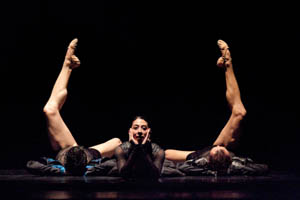
Jack Anderson
Discovering Tulsa Ballet
 |
| TULSA BALLET AT THE JOYCE -- Karina Gonzalez and Alfonso Martin. Photo by Christopher Jean-Richard |
Tulsa Ballet
Joyce Theater, 175 Eighth Avenue at 19th Street, Chelsea
August 10-15, 2009
Monday through Wednesday at 7:30 p.m.; Thursday and Friday at 8 p.m.; Saturday
at 2 and 8 p.m.; $39, $29, $19
Tickets: (212) 242-0800 or www.joyce.org
Reviewed by Jack Anderson, August 12, 2009
For dance lovers in New York, and many other parts of the country, Tulsa Ballet
must be perpetually discovered. To people in much of both the East and the
West, Tulsa is geographically remote, being way out there far from anywhere.
Yet audiences who do discover Tulsa Ballet can get excited about it, as I
know from my own experience.
Although it successfully appeared at Brooklyn College in the 1980's, its schedules then kept it away for decades. To see it, you probably had to travel to Tulsa, as I did on several occasions. But this summer when Tulsa Ballet finally came to Manhattan, it proved worth rediscovering; it should come back more often.
The company was founded in 1956 by Roman Jasinski, a Polish-born dancer, and his wife, Moscelyne Larkin, one of the remarkable Oklahoma-born American Indian ballerinas. The Jasinskis settled in Tulsa after dancing with both Col. de Basil's Ballets Russes and Sergei Denham's Ballet Russe de Monte Carlo. Jasinski died in 1991, Larkin retired, and since 1995 the artistic director has been Marcello Angelini, a much-traveled Italian-born dancer with eclectic tastes.
 |
| Ricardo Graziano, Serena Chu and Ma Cong. Photo by Ralph Cole. |
Under his guidance, Tulsa Ballet can show off diverse dancers from many national and ethnic backgrounds who perform with both gusto and polish so that they do not seem homogenized, but well harmonized. Their triple-bill was surely chosen to emphasize their energy, versatility, and finesse. If there were no masterpieces here (and the company has danced real masterpieces in the past), it was nonetheless an agreeable evening.
Its opener, Elite Syncopations, Kenneth MacMillan's portrait of a dance hall in the ragtime era, immediately revealed the dancers' brio as they capered to music by Scott Joplin and other composers of his era. It was unfortunate that the Joyce could not accommodate the on-stage musicians that usually accompany this ballet. It was also unfortunate that the company retained Ian Spurling's costumes that appear to have been inspired by colored ice-cream flavors: they make everyone look much too cute. So, at its weakest, does MacMillan's choreography. To their credit, the dancers did not overplay the cuteness; instead, everyone moved with disarming ease and unforced virtuosity, even managing to make the old choreographic joke of a tall ballerina (in this case, Marit van der Wolde) being partnered by a short man (Mugen Kazama) seem eternally fresh.
Nacho Duato's "Por Vos Muero" ("For You I Die") was much more serious, although precisely what it was being serious about was occasionally hard to fathom, through no fault of Duato or the cast. Set to gorgeous 15th and 16th-century Spanish music, it began with dancers in spare attire retreating into shadows from which they emerged in costumes by Duato and Ismael Aznar inspired by Renaissance period dress. A suite of incidents sent people skimming across the stage with impressive fleetness, something they probably could not have done had they been real Renaissance courtiers weighted by real Renaissance finery. There were scenes of passionate love and playful flirtation, as well as touches of mystery, as when women hid their faces behind masks or when men swung censers ominously.
The choreography was often striking and the dancing was impressive. But the overall point of the little scenes was difficult to ascertain: needlessly difficult, for a recorded voice solemnly intoned lines in Spanish by the 16th-century poet Garcilaso de la Vega which at the Joyce remained untranslated, although I was told that Tulsa audiences were provided with English versions of the text. So, much later in the evening, thanks to e-mail, were New York critics. The poem, which began "I am continually bathed in tears," went on to declare, "No one can be happy, Madam, / nor unhappy, unless he has looked at you," eventually concluding, "for you I was born, for you I am alive, / for you I have to die, and for you I die."
 |
| Rupert Edwards and Alexandra Bergman. Photo by Ralph Cole. |
Duato's vignettes presumably related to the poem's expressions of lovers' pangs. But because so much time had elapsed before I received a translation, it was hard to remember each little episode and how its steps might have reflected the words. And dancegoers who were not critics or fluent in Spanish were left to flounder in the untranslated dark.
Young Soon Hue, a South Korean choreographer little-known here, created her amiably outrageous "This Is Your Life" last year specifically for Tulsa Ballet. Named after an old radio and television show and capitalizing on the popularity of some of today's "reality" TV shows, it featured Joshua Trader as a smarmy TV host named Joshua Trader inviting other characters, all with the same names as the dancers, to reveal their pasts through words and movements. Some were eager, some reticent. Heaven knows if anything they said or did was literally true. Yet we became acquainted with, among other characters, a fussy hairdresser, some worried businessmen, and a philandering spouse. Much of the choreography, to a musical potpourri, was broadly comic. Yet hints of genuine pain behind the farce made "This Is Your Life" more than a romp and suggested Young Soon Hue may be a choreographer worth investigating.
And the entire program surely made many balletgoers happy to discover Tulsa
Ballet.
| museums | NYTW mail | recordings | coupons | publications | classified |
